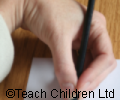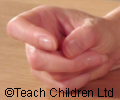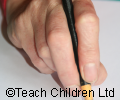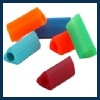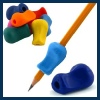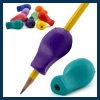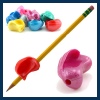Pencil grip difficulties
What is a poor pencil grip?
There are two types of poor pencil grip:
- where the web space is closed, restricting the movement of the fingers and wrist, which makes handwriting hard work, and
- where the hand is above the writing line; such as found with a hooked pencil grip.
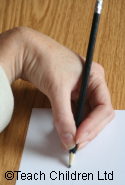



Closed web space
Hooked pencil
An open web allows the fingers to move freely, so that a fluid handwriting style can be achieved, which is why the Tripod Grip is considered the most appropriate for handwriting.

Open web

Children find a range of imaginative ways to hold a pencil if they are not supported and trained in developing a tripod pencil grip.
Poor pencil grips can develop for several reasons:
- some children do not have the muscle strength and finger dexterity required to hold a pencil correctly;
- others may have been forced to use an inappropriate grip for the stage in their development (which research highlights as causing a poor grip style later on);
- for a few it may be because they have been influenced and copied a peer or elders poor pencil grip.
Examples of poor pencil grips
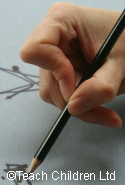

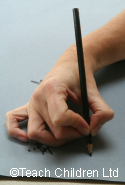
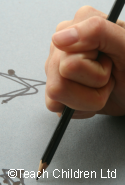
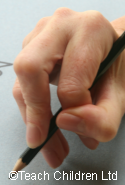
Remember, how a child holds a pencil is also dependent on their age and the stage of their development. Check a child’s grip against our ‘5 developmental stages of pencil grip’, as it may be they are holding the pencil correctly for their current level of ability.

Why you don’t want a child to have a poor pencil grip
A poor pencil grip can affect the quality of a child’s handwriting as well as putting unnecessary strain on the hand muscles and ligaments. This causes the hand to tense or cramp and tire quickly, making the handwriting process hard work. Many left-handed writers form a hooked grip that not only puts extra strain on the hand muscles and ligaments but the wrist and shoulder areas of the body.
The discomfort caused through a poor pencil grip not only makes handwriting hard work but frustrating or de-motivating as a child cannot produce the required quantity of written work. It is therefore important to check that a child is developing an appropriate pencil grip and to correct a poor grip as soon as it starts to appear.
Poor hand position can cause a poor pencil grip
We often talk about the most appropriate grip for handwriting being the tripod grip; but this usually only refers to finger position. It is easy to forget the importance of the actual hand position in relation to the pencil and paper for handwriting.
The ideal position is for the hand, wrist and elbow to be below the tip of the pencil and under the writing line for both left and right-handed writers.
Some children will hold the pencil in a tripod grip but develop a hooked hand position or move the elbow too far up the table, causing the forearm and wrist to be nearly horizontal with the table edge, because they feel they can see better what they are writing.
A hooked grip puts unnecessary strain on the hand ligaments and forces the body into a poor sitting position, again putting extra strain on the body. This in turn makes handwriting a tiring and uncomfortable task, impacting on a child’s overall learning experience.
It takes time to correct a poor hand position but it is well worth the perseverance as it will enable a child to write freely and more comfortably.
A good starting point is to plan some activities which can be done on a vertical surface. The vertical surface helps to strengthen the wrist and gets the child used to the feeling of the hand being in line with the wrist and forearm, rather than hooked or at an angle.
- Place the paper on a wall, with the middle at the child’s standing chest height, so they can write or draw with their hand, wrist and forearm in a vertical position.
- Encourage them to hold any writing or drawing tools using the tripod grip (age appropriate only) if you are focusing on improving a child’s hand position for handwriting.
- When writing normally, encourage them to angle the paper appropriately as this will also help to correct a poor hand position. With the correct paper tilt they will always be able to see what they are writing. If the paper is tilted at the correct angle for them they will find a hooked hand position, or having their forearm further up the table, more difficult and uncomfortable to maintain.
- Some children will find writing on a sloped desk helpful. Not all children are comfortable writing or drawing on a flat surface and may benefit from the paper being positioned on an angled or sloped board. If you are not sure, instead of buying a specialist board, you could make one. Try using a ring binder or lever arch file stuffed with magazines and newspaper to make a sloped board. Tape the edges to stop the papers falling out or you could cover it in sticky back plastic to give a smoother finish to the board. The advantage of this is that you can make them to any angle of slope. Try a few to see which, if any, a child prefers. You may find that the child only needs the sloped board for a short while. It may also help to reduce the angle of the slope over time so that they gradually get used to moving from a slopped to horizontal writing plane.
Ways to Correct a Poor Pencil Grip
If poor grip is due to poor hand and finger strength & dexterity
Coordination, finger and hand strength are important key strengths in being able to hold a pencil correctly for periods of time, so building these Key Strength areas is important. You can check a child’s hand and finger strength using our Key Strengths Assessment and support them using one of our Intervention Activity Programs (these can be found in our Key Strengths Section of the website).
While the child is developing their Key Strengths, or if they already have good Key Strengths you can use the following tips to help them to remember where to place their fingers and thumb to form a tripod grip:
- Place colour markers on the shaft of the pencil to show where to place the thumb and index finger when a tripod grip is used. For left-handed writers these should be placed further up the shaft than for a right-handed writer.
- Focus on one point at a time, for example, keeping the little finger and the ring finger gently curled in (try placing a cotton wool ball in the palm of the hand and having the child hold it in place with the little and ring finger). Then focus on the thumb position and index finger, finally the middle finger (a special padded sticker placed on the shaft of the pencil that rests on the middle finger can help).
- Try using a triangular shaped pencil, especially good for those just learning to handwrite, but watch the middle finger as it can sneak on top of the shaft rather than underneath.
- Use pencils of the appropriate thickness for the child and their fine motor skills ability. Young children usually require thicker pencils due to their gross and fine motor skills stage. As a child’s gross and fine motor skills develop the thickness of pencil required reduces.
- Some older children will benefit from using triangular or hexagon shaped pencil shafts, moving to smooth cylindrical shafts.
- With older children, who will understand, explain why it is important for them to change their pencil grip and how it will help them to improve the quality and quantity of their handwriting and be less tiring as the hand and fingers can move more freely. Understanding how and why can be a very powerful incentive for many children, especially if it makes sense to them and you can prove your point.
Handwriting pencil grip aids
Pencil grip aids generally do not correct the grip, they just force the hand and fingers into the correct position for writing. To correct the grip permanently the physical factors that have created the incorrect grip need to be addressed.
The use of grips can encourage a child to write more fluently, building their self esteem, whilst you work on correcting the factors that have caused a bad grip to form. The long term aim must always be to get the child to grip the pencil correctly without the use of aids.
Click on the pencil grips below to read about their features.
Alternative handwriting pencil grips
It has become increasingly evident that we need to look more carefully at alternative suitable efficient grips for handwriting. It is too easy for us to say that one particular grip is best and then plough on regardless and not really address the fact that one size, or in this case one method, does not fit all.
What is an efficient pencil grip?
“A pencil hold that provides speed, legibility is comfortable and will not cause harm to the joints of the hand over time. If a hold satisfies these criteria there is no need to change it”
(Benrow 2002, cited: Foundation of Paediatric Practice for the Occupational Therapy Assistant, 2005)
The following pencil grips are all considered to be efficient pencil grips for handwriting:
- The Dynamic Tripod Grip - the most appropriate grip for handwriting (the grip we would recommend teaching initially).
- The Quadrupod Grip - we see this grip as a developmental stage grip (stage 4) which can be developed on into the tripod grip.
- The Adaptive Tripod Grip - is in our opinion the next best to the tripod grip and would recommend it for:
- children who have low muscle tone or hyper mobility of the finger joints;
- older children who continue to hold a pencil too tightly;
- older children who hold the pencil lightly using just their fingertips (often writing using whole arm movements);
- older children (9+ year olds) who hold a pencil with their thumb wrapped around and across the pencil and index finger or whose poor pencil grip is proving difficult to adjust;
- adults who have a poor pencil grip and are teaching children to handwrite;
- adults who are developing arthritis in their fingers.
The quadrupod grip
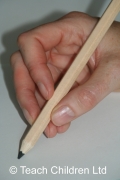
Here at Teach Children we see this grip as a developmental stage grip (stage 4) in younger children. This grip is used before they move on to a new grip, the dynamic tripod grip, considered the most appropriate grip for handwriting.
Older children who have not moved on to develop the tripod grip may require more focused support in developing gross and/or fine motor skills to help them make that transition.
The quadrupod grip is where the pencil is held between the top of the thumb, index and middle fingers and rests on the ring finger with the little finger slightly curled in. This creates a more elongated open web space compared to the rounder open web space of the tripod grip which means it is a little more restrictive because the fingers cannot move as freely.
It can be very difficult to get an older child to change their pencil grip especially if the old grip, like the quadrupod grip, is very similar to the new grip the dynamic tripod grip. This is when it becomes difficult to know whether to continue to try and make a child change their pencil grip or not.
So if older children do complain that their hand or fingers hurt or ache when they use the quadrupod grip, or that it is hindering their handwriting fluidity and speed, then we do need to support them in changing their grip. For some it may be more appropriate to introduce them to the adaptive tripod grip (see below) rather than trying to force them to use the dynamic tripod grip.
The adaptive tripod grip
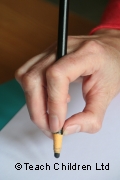
Here at Teach Children we would consider this as being the next best grip after the tripod grip for handwriting.
The adaptive tripod pencil grip is identical to the dynamic tripod grip in that the pencil is held between the tip of the thumb and index finger and rests on the middle finger. The main difference is that the shaft of the pencil rests in the ‘V’ between the index and middle finger. This gives a round though slightly smaller open web space to that created when using the tripod grip, but still allows the fingers to move freely so that a fluid handwriting style can be achieved.
The adaptive tripod grip is an alternative efficient pencil grip which we would recommend for:
- children who have low muscle tone or hyper mobility of the finger joints;
- older children who continue to hold a pencil too tightly;
- older children who hold the pencil lightly using just their fingertips (often writing using whole arm movements);
- older children (9+ year olds) who hold a pencil with their thumb wrapped around and across the pencil and index finger or whose poor pencil grip is proving difficult to adjust;
- adults who have a poor pencil grip and are teaching children to handwrite;
- adults who are developing arthritis in their fingers.
From the research we have carried out we cannot find any information suggesting that the grip needs to be adapted for left-handed writers.
Changing to the adaptive tripod grip is not a quick fix for children who have poor hand and finger strength. These strengths still need to be developed to make handwriting more comfortable.



